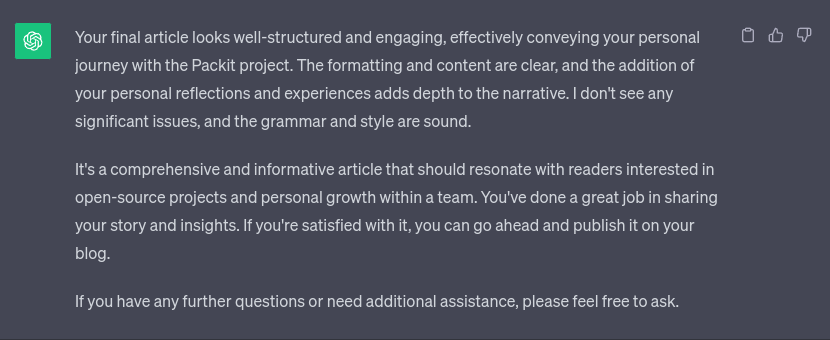How I became obsolete
It’s Saturday morning, 6:00 and I can’t sleep. My mind has decided to start functioning. I am tuning in some old Bonobo albums. This is a good time to write about how I got to the point that Packit team no longer needed me.

Packit project: the beginning
We’ll start with the birth of Packit.
$ git log --reverse
commit 4df26a6cc2afe31031f3f1adbf5b232a897adf96
Author: Tomas Tomecek <ttomecek@redhat.com>
Date: Tue Nov 6 11:24:40 2018 +0100
Initial commit
commit 180c970d3c6ac63ba5e3bf5c0a8ec9d063d86d70
Author: Tomas Tomecek <ttomecek@redhat.com>
Date: Wed Nov 7 14:44:48 2018 +0100
initial structure
Signed-off-by: Tomas Tomecek <ttomecek@redhat.com>
commit 7dae624120ff633a4c74348616c40a1c2db30baa
Author: lachmanfrantisek <flachman@redhat.com>
Date: Thu Nov 8 10:53:32 2018 +0100
Implement srpm generating
Signed-off-by: lachmanfrantisek <flachman@redhat.com>
I almost shed a tear when I saw this. It’s been almost 5 years since we started working on Packit with Franta (fun fact: initially the project was called source-git).
The beginning was rough: we knew what our long term goal was - automate RPM packaging process and enable folks easier integration process to Red Hat OS’s. But how to get there?
The struggle
Project kickoffs can be really frustrating. Now I can see a ton of things I’d change.
Here’s a list of things that didn’t go so well:
-
Expectations: we defined goals with our managers but unfortunately they proved to be overly ambitious. The project bootstrap took much more time than we expected.
-
Leadership: my role was tech lead from the start, I loved that! With Frantisek, we’ve had endless technical discussions about features, project structure, integration with Fedora Project and much more. In retrospect, I can see now that we needed a product owner as well to define the actual “product”.
-
Single-point-of-failure: once we had a production deployment, I was in charge of all the OpenShift stuff initially. The problem was that it took me a lot of effort to set up processes and documentation how we should handle production environment as a team. I still remember the frustration from constant interrupts to check what went wrong in the live service. Spoiler alert: Jirka did a stellar job with documenting our DevOps workflow and we also started a “Rotating roles” process soon.
-
PoC or MVP? Some of the early adopters were not happy. Packit worked well for Packit. Once the RPM packaging process was different, it broke. This situation was particularly frustrating as it led some early adopters to leave the project and develop their own solutions instead. The message for us was clear: we failed them.
It’s been 4 years, sadly I don’t have all the details any more. It’s possible some are incorrect.
Everyone grew
I don’t intend to write a book here. We’ve had several changes on the team over the years.
Nevertheless, we’ve managed to build a stable core Packit team. Four people saw the birth and carry immense knowledge of the project. I am grateful to be one of them together with Frantisek, Laura and Jiri. Though our present involvement varies and the past knowledge slowly drips away.
It was an honour to watch folks take on more responsibilities, be more active in chat and github, give talks, influence direction, research and develop features end-to-end, therefore slowly chipping away from my role as a product owner.
It got to a point that Franta took over most of my responsibilities in 2022. My only role was to be the main contact.
I was proud that we got so far with the project: we had hundreds of users, tenths active daily.
At the same time, I was depressed:
-
Well, what was my role on the project then?
-
Should I respond in chat and github? Create new issues? Pay attention to roadmap and long-term vision?
-
I tried to focus on the endgame: are we happy with our production cluster? can we integrate Packit somewhere else?
-
No matter what I did, deep down I knew something needs to change.
2023
I pursued opportunities outside of the team: trying something new.
It got me to Jan Zeleny who offered to mentor me.
His observation was spectacular:
Tomas, you are obsolete. They don’t need you anymore. Your work is done. You’ve made yourself obsolete and that’s a job well done.
He was right. I ignored the obvious truth all these months and chose to be depressed. At that point, I knew I had to quit the day-to-day team activities.
Especially retrospective, it would just be too emotionally painful for me to know, I am no longer involved in the daily operations.
Today
I’m still involved, they can’t get rid of me 😇, in a consultant-like role. But I’m also working on various new things.
With Irina, we are teaching another round of “Mastering Git” at FI MUNI.
Generative AI fascinates me. (Thank you, ChatGPT for helping me write this!)
This blog post provides my personal point of view. It does not reflect the views of my employer, Red Hat. I wrote it just to get “this” out of my head.
Did I miss anything significant? Is there a mistake? Please reach out and I’d be happy to correct it.
